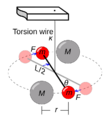Cavendish experiment facts for kids
The Cavendish experiment was a famous science experiment done in 1797–1798. An English scientist named Henry Cavendish performed it. It was the first time anyone measured the force of gravity between objects in a lab.
This experiment also helped scientists find the mass of the Earth for the first time. It gave very accurate numbers for how heavy our planet is. The idea for the experiment came from a geologist named John Michell. He designed the special equipment, but he passed away before he could finish the work. Henry Cavendish then took over. He rebuilt the equipment, following Michell's original ideas. Cavendish then did many tests and shared his findings in 1798.
Contents
How the Experiment Worked
The main part of the equipment was a special tool called a torsion balance. Imagine a wooden rod, about 6 feet long, hanging from a thin wire. At each end of this rod, there was a small lead ball. Each small ball was about 2 inches wide and weighed about 1.6 pounds.
Then, there were two much larger lead balls. These big balls were about 12 inches wide and weighed a huge 348 pounds each! They hung separately and could be moved close to the small balls.

Measuring Tiny Forces
The experiment measured the tiny pull of gravity between the small balls and the large balls. When the big balls were moved close, their gravity pulled on the small balls. This made the wooden rod twist just a little bit. The rod twisted until the force of the wire twisting back balanced the pull of gravity.
By measuring how much the rod twisted, Cavendish could figure out the strength of the gravitational force. He knew how much force it took to twist the wire by a certain amount. Since he could also weigh the small balls to find Earth's gravity on them, he could compare these forces. This comparison allowed him to calculate the density of the Earth.
Cavendish's Results
Cavendish found that the Earth's density was about 5.4 times denser than water. This was a very accurate measurement for his time. The number we use today is very close to his finding.
To make sure his measurements were correct, Cavendish also timed how long it took for the rod to swing back and forth. This helped him understand how much the wire resisted twisting.
The force he measured was incredibly small. It was like the weight of a tiny grain of sand! To stop air currents or temperature changes from messing up the experiment, Cavendish put the whole setup inside a large wooden box. This box was in a closed shed on his property. He watched the tiny movements of the rod through telescopes from outside the shed.
Cavendish's equipment was super sensitive for its time. His results were the most accurate for many years. Even today, scientists still use similar methods to measure gravity.
Why the Experiment Was Important
Cavendish's experiment helped prove that the Earth has a dense core made of metal. His results showed that the Earth's center must be much heavier than its outer layers. This idea had been suggested before, but Cavendish's work provided strong evidence.
Measuring the Gravitational Constant
Even though Cavendish didn't use the term "gravitational constant" (G), his experiment was the first to accurately measure it. This constant is a key part of Newton's law of universal gravitation. It tells us how strong the force of gravity is between any two objects.
Cavendish thought of his experiment as "weighing the world." Later scientists used his results to calculate the value of G. His calculated value for G is very close to what physicists use today. This shows how amazing his experiment was!
Images for kids




